It is the greatest challenge for a technically minded leader like a CISO to be able to map the information security risks that they know face the enterprise to the business outcomes such that business-side leaders can understand them. Dating back to the origin of the position, CISO’s have been charged with bridging the gap between cyber risk and business outcomes and key risk indicators are their secret weapon.
Key Risk Indicators
The definition of key risk indicators (KRIs) is the tactical application of a risk appetite statement. Unlike Key Performance Indicators (KPIs) which are a backward looking indicator, KRI is a forward looking indicator to predict where your organization is going. KRIs include all facets of an organization and allow for early warning of significant potential risks that can be expressed to the board and mitigated with key controls. For cyber risk management teams, CISO’s among them, that manage internal controls, cybersecurity key risk exposure indicators are listing the benefits and the type of risks associated with that strategy.
These Key Risk Indicators (KRI) are the marriage of the desired outcome from the C-suite and the technical knowledge from the security professionals that have been embedded in this practice for years and deliver value to both sides.
Practically Applying Your Risk Appetite Statement
To effectively operationalize your risk quantification practices in a business environment, the enterprise leadership must understand and map those cyber risk metrics to the outcomes of a strategic goal they want to achieve (otherwise, why accept the risk). For technical leaders like a CISO, having the processes in place to monitor performance and facilitate the delivery of that risk data so that developed key technological risks are understandable to business units and leaders is critical. C-suite members and the board need key performance and risk indicators in the digital age, and communication breakdown often stops them from getting it.
Taking the high-level strategy of an organization’s operational risk appetite statement and breaking it down to develop effective KRIs empowers risk managers to understand and feed the critical metrics and risk trends back up to senior management.
KRI’s Give The CEO Room To Understand Cyber
With data breaches capturing headlines weekly, CEOs are becoming increasingly concerned with their cyber posture. However, this is a whole new classification of risk events for CEOs and BoDs that leaves them searching for answers in ways that will fit into their current methodologies of risk monitoring. With cyber-focused KRIs that the CISO constructs in tandem with the strategy put out by the CEO, this helps the CEO understand the risks associated with the strategy - and either accept or reject that level of risk.
Effectively developing and identifying good KRIs to empower business leaders and security teams with an understanding of the other party allows both to work more closely and further integrate cybersecurity risk management into the executive leadership conversation.
If you have any questions about KRIs and KPIs, cyber risk, or how using an integrated cyber risk management solution like CyberStrong can help streamline and automate your cybersecurity initiatives, supply chain compliance, and performance management in real-time, give us a call at 1-800 NIST CSF or click here to learn more.





.png)
.png)
.png)
%201.png)
.png)




